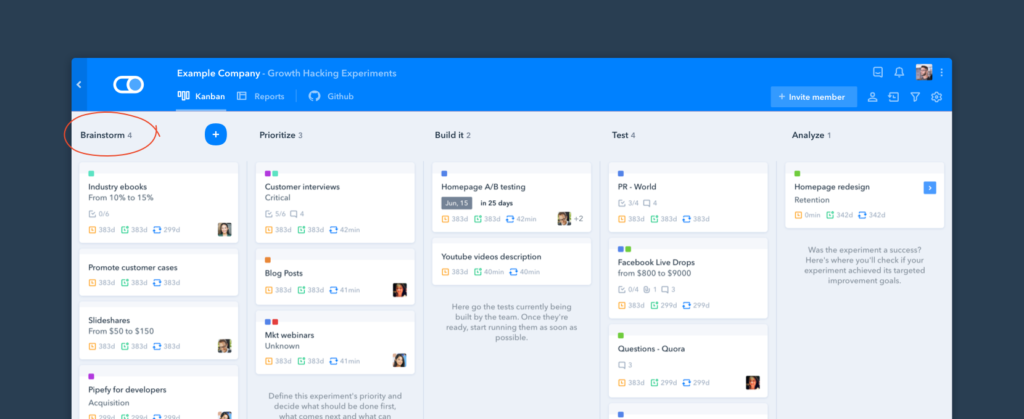ARTICLE SUMMARY
Unless you've been living under a rock for the past few years, the term growth hacking should already be part of your company's vocabulary. It should come as no surprise, specially if your company is a startup/small company what growth hacking is and how you - and your company - can benefit from it.

Unless you’ve been living under a rock for the past few years, the term growth hacking should already be part of your company’s vocabulary. It should come as no surprise, specially if your company is a startup/small company what growth hacking is and how you – and your company – can benefit from it.
The concept of growth hacking is, more often than not, mistaken for “just another marketing strategy” – we’ve already written about how growth hacking differentiates from traditional marketing here on the blog, but it’s important that you know that most of the acclaimed growth hacking techniques involve a lot of AB testing, hypothesis, and experimenting.
To help you with that, Pipefy developed, together with the distribution team from 500 startups, a template that’s focused exclusively on help you developed – and test – your company’s growth hacking experiments. This template united and refined growth strategies from over 1,200 startups and tightened them all up as an awesome template you can import into your organization and start using right now.
What are Growth Hacking Experiments?
A growth hack is, to define it simply, a way to boost your company’s growth in a cheap and organic way , other than traditional initiatives that involve spending a lot more money. It’s not a particularly tricky concept and, most of the times, people tend to imitate the strategies other companies used before.
However, in order to actually know whether something that worked for a company with similar characteristics will work for yours, you have to run some tests instead of just getting out there without even testing the hypothesis. Those would be your company’s growth hacking experiments.
It’s safe to say that most of the ideas going around are versions (it sounds better than saying they’re copies) of something else someone did before. In order to know what you’ll need to adapt, how one strategy or another works in your environment, you have to develop your own hypothesis and tests on your own environment. As your mom probably told you as a kid, you’ll never know unless you try.
Using process management software such as Pipefy will help you manage your own growth hacking experiments: it comes with pre-defined standards (fully customizable to suit your needs) to make sure all your experiments follow the same execution standards and are all in one place, making it a lot easier to monitor their results.
Why use Pipefy’s Growth Hacking Experiments Template?
Pipefy’s Growth Hacking Experiments Template begins with a phase called Brainstorm – this is where all incoming experiment ideas will arrive. On Pipefy, each experiment is represented by a card created using a simplified form where you’ll need to input the following information:
- What is your idea? – A brief description of your idea for an experiment.
- Where does it impact? – Choose of your company’s metrics will be impacted by this experiment. Choose from acquisition, activation, retention, revenue and referral.
- Describe your experiment – Details about your experiment idea. How do you thing it should be developed, what are the expected results, etc.
All new experiment ideas arrive in the Brainstorm phase. On this phase, before the task can move forward, you’ll need to provide further information:
- What is the success metric?
- What is your goal?
- What is the impact on your user base?
- What’s the confidence rate?
- How much effort will it take?
- How will you measure the results?

After you do that, the experiments will be moved to the Prioritize phase, in which you’ll define what’s the priority of going on with this experiment.
The next phase is Build it: only the experiments your team is currently working on building should be on this phase.
After the experiments are all ready, they should be moved forward to the Test phase.
The information you need to add on this phase are the start and end dates of the experiment. You can create a reminder by setting up a due date in which you have to go back and check the results.
After the test is over, you’ll get to the last active phase on this pipe: Analyze. This is where you’ll determine how did your test go and how the metrics you determined on the beginning of the process where affected.
The analysis includes the following information:
- What’s the improve/decrease percentage?
- Did the test achieve its goals?
- What were the experiment’s results?
- What did you learn from this experiment?

When the cards reach the end of the pipe, you’ll move them to Live or Archived if for some reason you had to leave them aside.
To sum things up…
Growth strategies refined across over 1,200 startups, tightened up as a template you can start using right now.
Pipefy’s Growth Hacking Experiments was developed by the 500 Startups Distro Team, inspired by Brian Balfour, Growth VP @Hubspot. Here’s what he has to say about “The Scientific Method: How to Design & Track Viral Growth Experiments”:
It’s not just about viral experiments, we use this as a foundation for everything we do in the growth team at Hubspot










